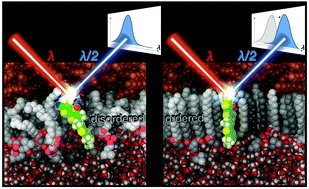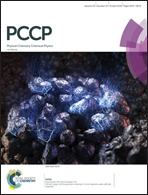Detecting order and lateral pressure at biomimetic interfaces using a mechanosensitive second-harmonic-generation probe†
Abstract
A planarizable push–pull molecular probe with mechanosensitive properties was investigated at several biomimetic interfaces, consisting of different phospholipid monolayers located between dodecane and an aqueous buffer solution, using the interface-specific surface-second-harmonic-generation (SSHG) technique. Whereas the SSHG spectra recorded at liquid-disordered interfaces were similar to the absorption spectra in bulk solutions, those measured at liquid-ordered phases exhibited a remarkable shift towards lower energies to an extent depending on the surface pressure of the phospholipid monolayer. On the basis of quantum-chemical calculations, this effect was accounted for by the planarization of the mechanosensitive probe. Polarization-resolved SSHG measurements revealed that the average orientation of the probe at the interface is an even more sensitive reporter of lateral pressure and order than the spectral shape. Additionally, time-resolved SSHG measurements pointed to slower dynamics upon intercalation inside the phospholipid monolayer, most likely due to the more constrained environment. This study demonstrates that the concept of mechanosensitive optical probes can be further exploited when combined with a surface-selective nonlinear optical technique.



 Please wait while we load your content...
Please wait while we load your content...